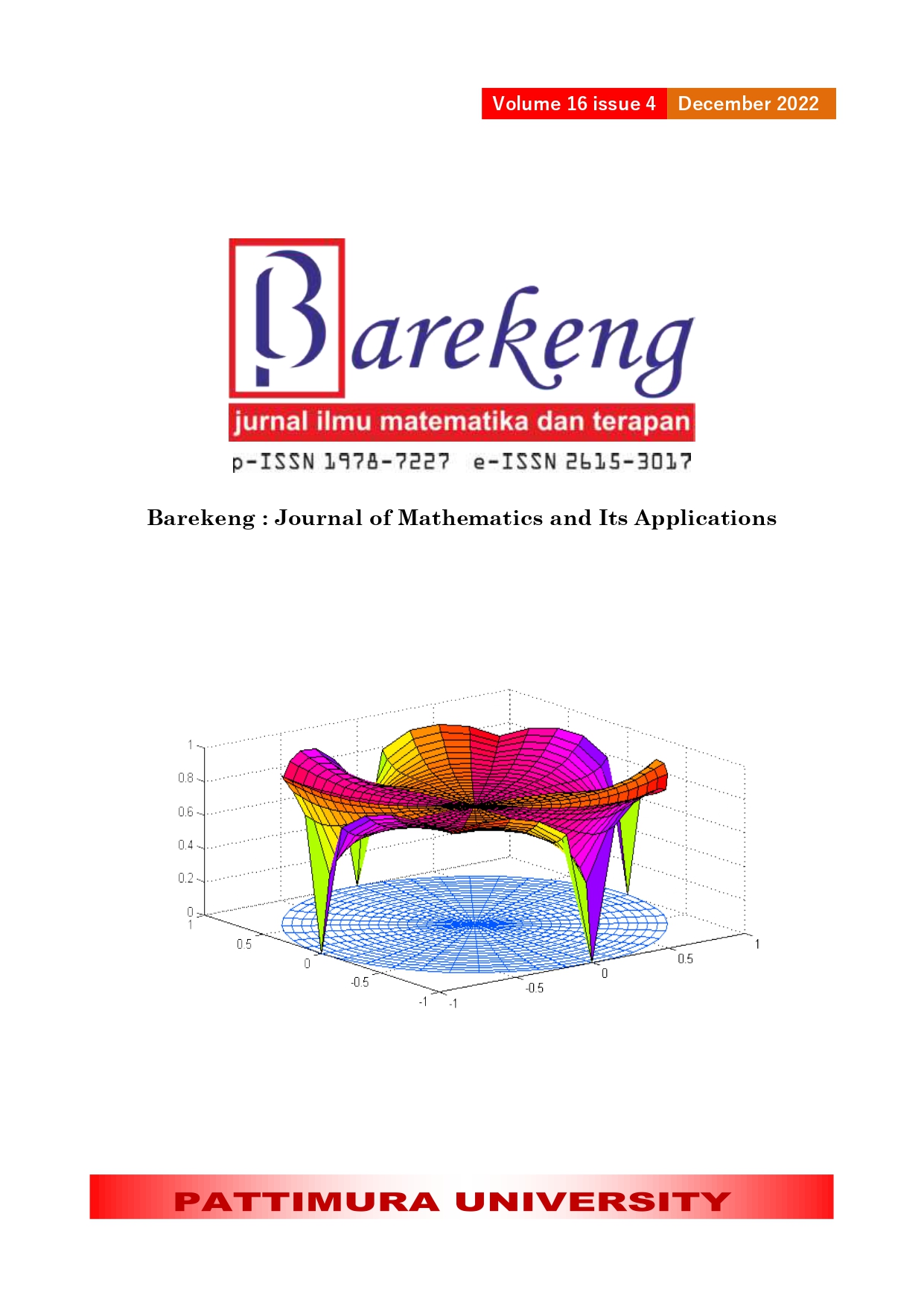POISSON REGRESSION MODELLING OF AUTOMOBILE INSURANCE USING R
Abstract
Automobile insurance benefits are protecting the vehicle and minimizing customer losses. Insurance companies must provide funds to pay customer claims if a claim occurs. Insurance claims can be modelled by Poisson regression. Poisson regression is used to analyze the count data with Poisson distributed data responses. this paper, the data model of sample is automobile insurance claims from the companies in one year (in 2021) of observation which contains three types of insurance products, i.e., Total Loss Only (TLO), All Risk, and Comprehensive. The results of data analysis show that the highest number of claims comes from Comprehensive insurance products, especially if the premium value gets more extensive. In contrast, the least comes from TLO insurance products.
Downloads
References
European Insurance and Occupational Pensions Authority, Open Insurance: Accessing and Sharing Insurance-Related. Luxembourg: Publications Office of the European Union, 2021, doi: 10.2854/013491.
C. A. Colin and T. Pravin, Regression Analysis of Count Data, 2nd ed. Cambridge: Cambridge University Press, 2013, doi: 10.1017/CBO9781139013567.
M. Karim and A. K. Mutaqin, “Modeling Claim Frequency in Indonesia Auto Insurance Using Generalized Poisson-Lindley Linear Model,” J. Mat. Stat. dan Komputasi, vol. 16, no. 3, pp. 428-439, 2020, doi: 10.20956/jmsk.v16i3.9315.
J. S. K. Chan, S. T. B. Choy, U. Makov, A. Shamir, and V. Shapovalov, “Variable Selection Algorithm for a Mixture of Poisson Regression for Handling Overdispersion in Claims Frequency Modeling Using Telematics Car Driving Data,” Risks, vol. 10, no. 4, p. 83, 2022, doi: 10.3390/risks10040083.
J. M. Hilbe, Modeling Count Data. Cambridge: Cambridge University Press, 2014, doi: 10.1017/CBO9781139236065.
R. E. Walpole, R. H. Myers, S. L. Myers, and K. Ye, Probability & Statistics for Engineers & Scientists, 6th ed. Hoboken: Pearson, 2012.
R. Winkelmann, Econometric Analysis of Count Data, 5th ed. Berlin: Springer, 2008, doi: 10.1007/978-3-540-78389-3.
A. C. Rencher and W. F. Christensen, Methods of Multivariate Analysis, 3rd ed. Hoboken: John Wiley and Sons, 2012.
L. Zhang, W. Zhang, Y. Li, J. Sun, and C. X. Wang, “Standard Condition Number of Hessian Matrix for Neural Networks,” IEEE Int. Conf. Commun., vol. 2019-May, pp. 1–6, 2019, doi: 10.1109/ICC.2019.8761740.
S. W. Indratno, “Asuransi Kendaraan Bermotor,” Rpubs. 2018, [Online]. Available: https://rpubs.com/saptoWI/401535.
R. D. Kurnia, “16 Produk Asuransi Mobil Terbaik dan Terpercaya di,” Qoala. 2022, [Online]. Available: https://www.qoala.app/id/blog/asuransi/mobil/daftar-asuransi-mobil-terbaik/
M. R. Yudhanegara and K. E. Lestari, “Clustering for multi-dimensional data set: A case study on educational data,” J. Phys. Conf. Ser., vol. 1280, no. 4, p. 042025, 2019, doi: 10.1088/1742-6596/1280/4/042025.
M. R. Yudhanegara, S. W. Indratno, and R. R. K. N. Sari, “Clustering for Items Distribution Network,” J. Phys. Conf. Ser., vol. 1496, no. 1, p. 012019, 2020, doi: 10.1088/1742-6596/1496/1/012019.
M. R. Yudhanegara, S. W. Indratno, and R. K. N. Sari, “Clustering for Item Delivery Using Rule-K-Means,” J. Indones. Math. Soc., vol. 26, no. 02, pp. 185–191, 2020, doi: 10.22342/jims.26.2.871.185-191.
M. R. Yudhanegara, S. W. Indratno, and R. K. N. Sari, “Dynamic items delivery network: prediction and clustering,” Heliyon, vol. 7, no. 5, p. e06934, 2021, doi: 10.1016/j.heliyon.2021.e06934.
M. R. Yudhanegara, S. W. Indratno, and K. N. Sari, “Role of clustering method in items delivery optimization,” J. Phys. Conf. Ser., vol. 2084, no. 1, p. 012011, 2021, doi: 10.1088/1742-6596/2084/1/012011.
S. W. Indratno, K. N. Sari, and M. R. Yudhanegara, “Optimization in Item Delivery as Risk Management: Multinomial Case Using the New Method of Statistical Inference for Online Decision,” Risks, vol. 10, no. 6, p. 122, 2022, doi: 10.3390/risks10060122.
Copyright (c) 2022 Sandy Vantika, Mokhammad Ridwan Yudhanegara, Karunia Eka Lestari

This work is licensed under a Creative Commons Attribution-ShareAlike 4.0 International License.
Authors who publish with this Journal agree to the following terms:
- Author retain copyright and grant the journal right of first publication with the work simultaneously licensed under a creative commons attribution license that allow others to share the work within an acknowledgement of the work’s authorship and initial publication of this journal.
- Authors are able to enter into separate, additional contractual arrangement for the non-exclusive distribution of the journal’s published version of the work (e.g. acknowledgement of its initial publication in this journal).
- Authors are permitted and encouraged to post their work online (e.g. in institutional repositories or on their websites) prior to and during the submission process, as it can lead to productive exchanges, as well as earlier and greater citation of published works.






1.gif)



